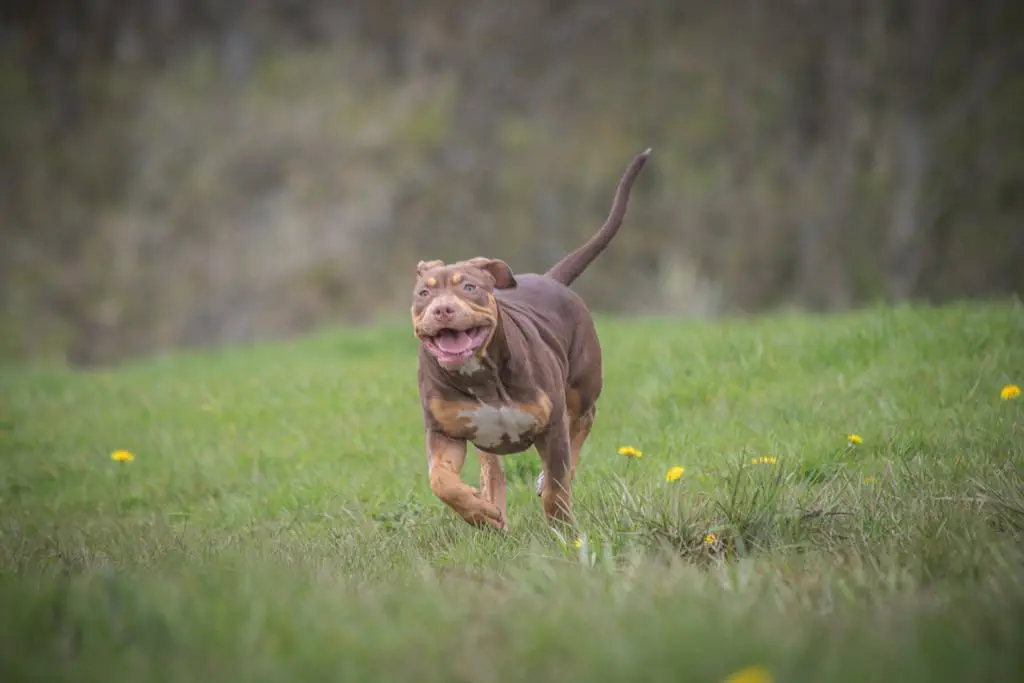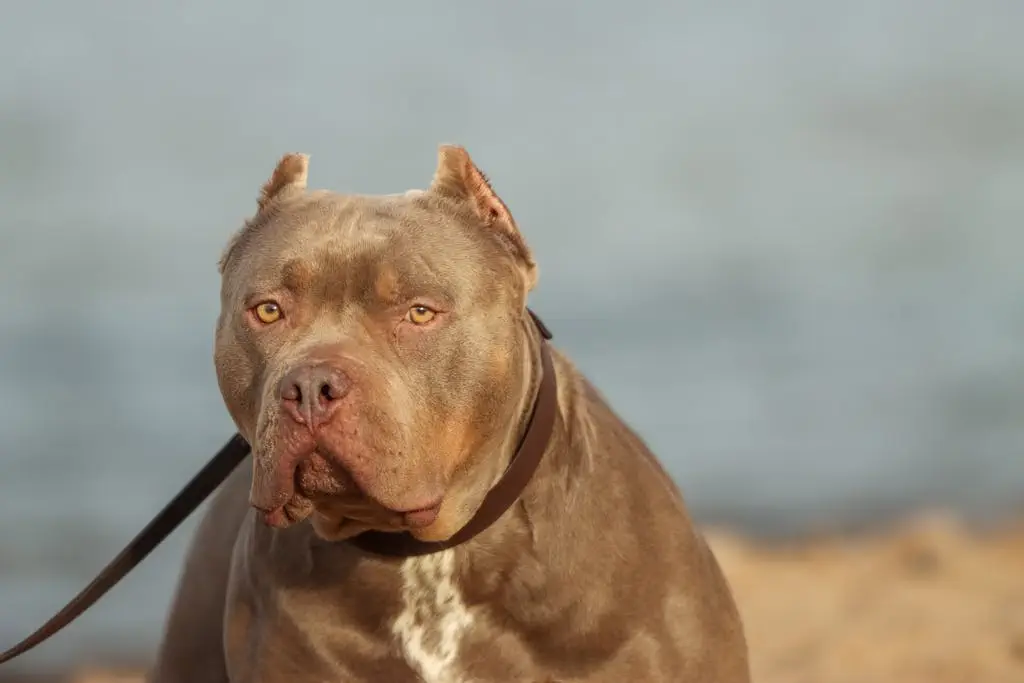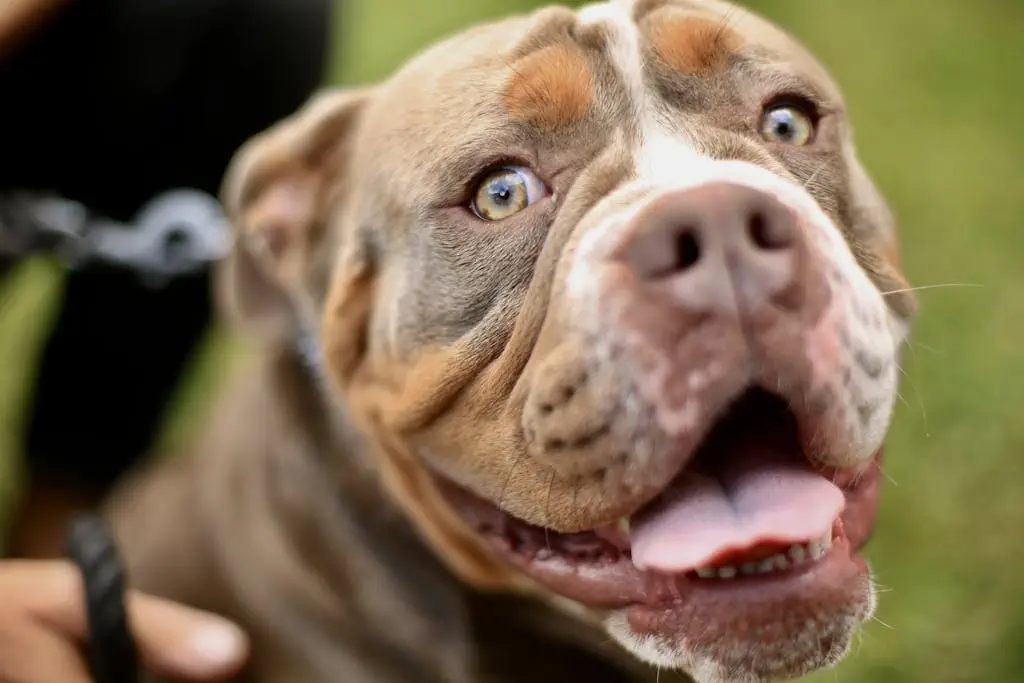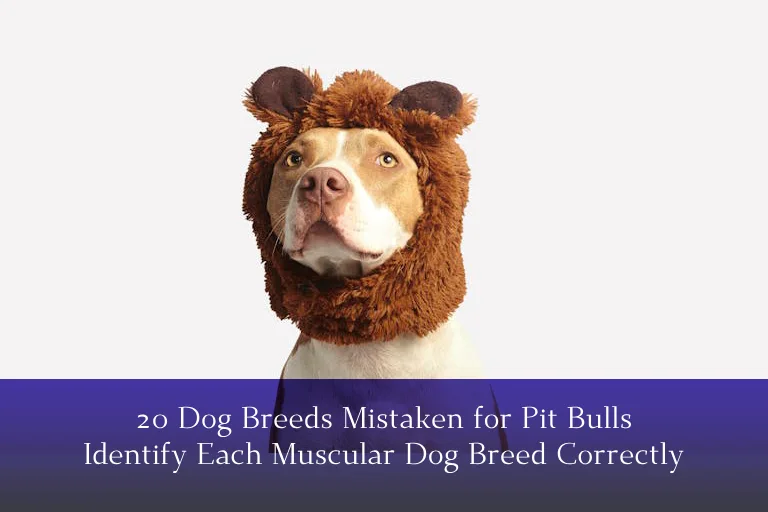You might think you know what a pit bull looks like, but many muscular breeds are often confused for them. If you’re trying to identify a dog accurately, it helps to understand subtle differences in build, head shape, and coat. Mistaking one breed for another can lead to misunderstandings, so knowing what sets each apart is essential. Keep in mind, the truth goes beyond just appearances—and that’s where it gets interesting.
Establishing expertise: Understanding dog breeds often mistaken for pit bulls

You’ll notice that pit bulls share key traits like a muscular build and certain bloodline features with several other breeds, which often leads to confusion. Understanding these physical characteristics helps you spot why people mistake other dogs for pit bulls.
Plus, public perception plays a big role in how these breeds are identified, so knowing the facts puts you ahead.
Characteristics of the pit bull and why other dog breeds are mistaken for pit bulls
Although pit bulls have distinct physical and behavioral traits, many dog breeds share similar features that lead to frequent misidentification. When you understand pitbulls’ breed standards, you’ll see their compact, muscular build paired with a confident personality. Their coat types usually come short and smooth, contributing to their recognizable look. (Citizen Shipper, Pawlicy)
However, several muscular dog breeds exhibit comparable body shapes and coat styles, causing confusion. As someone committed to helping others, you can educate on these subtle differences, ensuring each dog is identified correctly and treated fairly.
Bloodline and muscular build: Common traits in pit bull and similar breeds
Recognizing why so many dog breeds are mistaken for pit bulls starts with understanding their shared bloodlines and muscular builds. When you focus on breed identification, you’ll notice that several breeds share similar bloodline origins, which influence their sturdy, muscular build.
These breed traits contribute to a canine appearance often associated with strength and agility. By learning the subtle differences in muscle structure, head shape, and coat patterns, you can more accurately distinguish pit bulls from look-alike breeds. (YCSPCA, AKC)
Serving others involves helping them appreciate these nuances, reducing misidentification. Knowing how bloodline affects physical traits allows you to respect each breed’s unique characteristics while acknowledging their common muscular build. This knowledge empowers you to promote accurate breed identification with confidence and clarity.
The role of public perception in identifying dog breeds that look like pit bulls
When people encounter dogs with muscular builds and broad heads, they often jump to label them as pit bulls, regardless of the actual breed. This public perception can lead to breed misidentification, especially among muscular dog breeds that share similar physical traits.
As someone committed to serving others, you understand that accurate breed identification is essential—not only to educate but also to protect dogs from unfair stigma. Mislabeling dogs can contribute to the enactment of breed-specific legislation, which often targets pit bulls and lookalikes unfairly.
Detailed overview of popular dog breeds mistaken for pit bulls

You’ll notice that breeds like the Bull Terrier and American Bulldog share some traits with pit bulls but have key differences. Comparing Staffordshire Bull Terriers and American Staffordshire Terriers to pit bulls helps clear up confusion (AKC). Plus, muscular breeds like the Cane Corso, Dogo Argentino, and various mastiffs each have unique features you should recognize.
Here’s the list of 20 dog breeds often mistaken for pit bulls:
- Bull Terrier
- American Bulldog
- Staffordshire Bull Terrier
- American Staffordshire Terrier
- Cane Corso
- Dogo Argentino
- Mastiff
- Bullmastiff
- Ambullneo Mastiff
- American Bully
- Olde English Bulldogge
- Boxer
- Dogue de Bordeaux
- Boerboel
- Presa Canario
- Rhodesian Ridgeback
- Rottweiler
- Staffordshire Terrier Mix
- American Pit Bull Terrier* (Note: closely related breed often confused)
- American Bulldog Mix
Bull terrier and american bulldog: Key differences and similarities
Although bull terriers and American bulldogs share a muscular build and strong presence, you’ll find distinct traits that set them apart. When focusing on breed identification, the bull terrier stands out with its unique egg-shaped head and triangular eyes, while the American bulldog has a broader face with a more pronounced jawline.
Both muscular dogs exude strength, but the bull terrier is generally smaller and more agile compared to the bulkier, sturdier American bulldog. Understanding these breed differences helps you serve others better by accurately recognizing each dog’s unique qualities.
Staffordshire bull and american staffordshire terrier in comparison to the pit bull
Since many people confuse Staffordshire Bulls and American Staffordshire Terriers with Pit Bulls, it’s important to understand their distinct features. When serving others by educating about muscular dog breeds, clear breed comparison helps avoid misidentification and promotes responsible care.
| Breed | Size | Temperament |
|---|---|---|
| Staffordshire Bull | Medium, stocky | Loyal, affectionate |
| American Staffordshire Terrier | Larger, muscular | Confident, friendly |
| Pit Bull | Medium, athletic | Energetic, protective |
You’ll notice the Staffordshire Bull is more compact, while the American Staffordshire Terrier shows a stronger build but shares a friendly nature. Pit Bulls tend to be more athletic yet equally loving. Understanding these differences guarantees you support proper training and care for each muscular dog breed.
The cane corso and dogo argentino: Muscular breeds often confused with pit bulls
When you spot a large, muscular dog, it can be easy to mistake a Cane Corso or Dogo Argentino for a Pit Bull due to their powerful builds and confident stances. Both cane corso and dogo argentino belong to muscular breeds known for strength and agility, which often leads to pit bull confusion.
To serve others better, you need sharp breed identification skills. The cane corso typically has a broader head and a more massive frame, while the dogo argentino is leaner with a distinctive white coat.
Recognizing these subtle differences helps you advocate for accurate perceptions and responsible ownership. By learning to identify these breeds correctly, you contribute to reducing misunderstandings and promoting the welfare of all muscular breeds often mistaken for pit bulls.
Unique traits of mastiff, bullmastiff, and ambullneo mastiff in breed identification
You’ll often see mastiffs, bullmastiffs, and ambullneo mastiffs mistaken for pit bulls because of their imposing size and muscular builds. When focusing on breed identification, it’s important to note key breed traits that set these muscular dogs apart.
Mastiffs typically have a broader head and a more massive frame compared to pit bulls. Bullmastiffs, a mix of bulldog breeds and mastiffs, show a unique blend of strength and agility with a distinct square muzzle. Ambullneo mastiffs combine traits from American bulldogs and mastiffs, resulting in a taller, leaner muscular dog with a pronounced jawline.
Current research and common misconceptions about dog breeds mistaken for pit bulls

You might be surprised to learn that scientific studies show many dogs labeled as pit bulls are often misclassified. It’s important to challenge common myths about aggression and fearlessness linked to pit bulls and their lookalikes.
Understanding the unique traits of breeds like the American Bully, Olde English Bulldogge, and American Pit Bull Terrier helps clear up confusion.
Scientific studies on breed identification and misclassification risks
Although many people assume visual identification is reliable, scientific studies reveal that breed identification, especially for dogs labeled as pit bulls, often involves significant misclassification risks. When you serve dog owners or communities, understanding these challenges helps prevent unfair judgments and promotes better care.
Here’s what research shows:
- Breed-specific knowledge matters: Experts using genetic testing find breed identification based on dog appearance alone is often inaccurate.
- Misclassification risks are high: Many muscular breeds share similar traits, causing frequent errors in labeling dogs as pit bulls.
- Scientific studies encourage caution: Relying solely on visual cues can lead to misunderstandings and affect dogs’ welfare negatively.
Misconceptions about fearlessness and aggression in pit bulls and lookalike breeds
When people misidentify certain breeds as pit bulls, they often assume these dogs are inherently fearless or aggressive, but current research challenges these stereotypes.
You should know that aggressive behaviors aren’t tied to any one breed, including pit bulls or their lookalike breeds. Misconceptions arise from breed mistaken identity, leading to unfair judgments and mistreatment.
Instead of focusing on breed alone, you can better serve dogs by understanding individual temperaments and proper training. Recognizing these myths helps you advocate for responsible pet ownership and supports dogs who may be wrongly labeled aggressive due to their appearance.
Interpreting breed characteristics in american bully, olde english, and american pit bull terrier
Three popular breeds—the American Bully, Olde English Bulldogge, and American Pit Bull Terrier—often get mistaken for one another due to their similar muscular builds and facial features. To serve others better, you should understand their distinct breed characteristics.
- American Bully: Known for a stocky, compact frame and a friendly disposition, this breed is muscular but less aggressive than assumed.
- Olde English Bulldogge: This breed has a broader head and a more substantial body, reflecting its heritage aimed at health and longevity.
- American Pit Bull Terrier: Athletic and agile, this breed is leaner with a strong jaw, often misunderstood due to its muscular appearance.
Recognizing these muscular dog breeds helps you advocate for each dog’s true nature and care needs.
Expert recommendations for correctly identifying and differentiating dog breeds mistaken for pit bulls

You’ll want to focus on key physical traits and bloodlines to tell breeds like boxers, dogue de bordeaux, and boerboels apart from pit bulls. Understanding these differences helps avoid confusion with bull terriers, too.
Experts also offer personalized tips for owners of staffordshire bulls and pit bulls to manage their dogs’ unique appearances.
Best practices for distinguishing boxer, dogue de bordeaux, and boerboel from pit bull breeds
Although pit bulls share some physical traits with boxers, dogue de bordeaux, and boerboels, you can spot key differences by focusing on their size, head shape, and coat texture.
To help with breed identification, pay attention to these distinguishing features:
- Boxer: Look for a square jaw, shorter muzzle, and smooth, shiny coat. Boxers are more athletic and lean compared to pit bulls.
- Dogue de Bordeaux: Notice the massive head with pronounced wrinkles and a loose, thick skin. Their coat is short but softer than pit bulls.
- Boerboel: Recognize their larger, heavier build and broader chest. Their head is broad but less wrinkled than the dogue de bordeaux.
Evaluating bloodline and physical traits to avoid confusion with bull terriers
When trying to distinguish bull terriers from pit bulls, you should examine both their bloodline and physical traits carefully. Knowing the unique bloodline helps prevent pit bull confusion, especially since bull terriers share muscular builds but differ in head shape and body structure. Physical traits like the bull terrier’s egg-shaped head contrast with the broader, more square head of the pit bull or bulldogge mixes. Accurate breed identification supports responsible care and advocacy.
| Trait | Bull Terrier |
|---|---|
| Head Shape | Egg-shaped, elongated |
| Body Structure | Muscular, compact |
| Bloodline | Distinct lineage |
| Common Confusion | Pit bull, bulldogge |
Focus on these key points to help others recognize and serve these breeds appropriately.
Personalized advice for owners and enthusiasts dealing with staffordshire bull and pit bull appearances
Understanding the subtle differences in bloodlines and physical traits sets a strong foundation, but distinguishing Staffordshire Bull Terriers and Pit Bulls requires even closer attention. When you’re passionate about muscular dog breeds, personalized advice helps you improve breed identification and support responsible ownership. Here’s how you can approach it:
- Observe head shape and size closely—Staffordshire Bulls have a broader skull, while Pit Bulls tend to have a more elongated face.
- Note body proportions; Staffordshire Bulls are compact and stocky, whereas Pit Bulls are leaner and more athletic.
- Engage with breed clubs or forums to learn from experienced owners who share insights on behavior and appearance.
Comparing 20 dog breeds mistaken for pit bulls: Evolution, trends, and future identification strategies

You’ve probably noticed how the original pit bull and bull terriers shaped how we identify these breeds today. Recognizing American Staffordshire Terriers and American Bullies is becoming more common in both public and legal settings.
As genetic testing advances, you’ll see clearer breed classifications that could change how laws treat these dogs.
How the original pit bull and bull terriers influenced modern perceptions of dog breed identity
Although the original pit bull and bull terriers share a common ancestry, their distinct features have shaped how people identify and often misidentify these dogs today. Understanding these breed influences helps you navigate modern perceptions and improve breed identification, especially among bully breeds.
Here’s what you should know:
- The pit bull’s muscular build and blocky head set a standard that many bully breeds mimic, causing confusion.
- Bull terriers’ unique egg-shaped heads contrast with pit bulls, but both breeds’ robust physiques blur public recognition.
- Media and cultural portrayals have amplified these breed influences, impacting how you and others perceive and classify these dogs.
Trends in recognizing american staffordshire terrier and american bully in public and legal contexts
The strong physical traits inherited from pit bulls and bull terriers often lead to confusion when identifying similar breeds like the American Staffordshire Terrier and American Bully. When you help others understand these dog breeds mistaken for pit bulls, you play a key role in improving public recognition.
In many communities, these breeds face misidentification in public and legal contexts, sometimes resulting in unfair restrictions or stigma. By educating yourself and sharing accurate information, you can support fair treatment and better breed-specific policies.
Recognizing subtle differences between the American Staffordshire Terrier and American Bully helps reduce mislabeling and fosters responsible ownership. Your effort in clarifying these distinctions promotes respect for these breeds and aids lawmakers and the public in making informed decisions.
Future developments in breed classification including genetic testing and breed-specific legislation
As genetic testing becomes more accessible and accurate, you’ll see significant changes in how breeds mistaken for pit bulls are classified. Advances in canine genetics will improve breed identification, helping you serve communities by reducing mislabeling and stigma.
Future breed classification will likely involve:
- Widespread use of genetic testing to confirm breed heritage, providing objective data beyond appearance.
- Revisions in breed-specific legislation based on genetic evidence, promoting fairer laws and better public safety.
- Enhanced education for animal control and shelters to apply science-backed breed identification, improving outcomes for dogs and owners.
Conclusion
Now that you know how to spot the unique traits of these muscular breeds, you’ll feel more confident identifying them correctly and avoiding common mix-ups with pit bulls. Understanding each breed’s distinct features helps promote responsible ownership and challenges unfair stereotypes. Keep these tips in mind, and you’ll not only appreciate each dog’s individuality but also contribute to better awareness and respect for all breeds. Accurate identification truly makes a difference.
FAQs
1. Are Pit Bulls More Aggressive Than Other Muscular Breeds?
You shouldn’t assume pit bulls are more aggressive than other muscular breeds. Their behavior depends on training and environment. When you provide consistent care and socialization, any dog can be friendly, loyal, and well-behaved.
2. What Are the Best Training Tips for Pit Bull Mixes?
You should use positive reinforcement, stay consistent, and be patient when training pit bull mixes. Socialize them early, set clear boundaries, and provide plenty of exercise. This helps your dog grow confident, well-behaved, and happy.
3. How Does Diet Affect the Muscle Development of These Breeds?
You’ll see muscle growth improve when you feed balanced, protein-rich meals. Quality nutrients fuel strength and recovery, so providing consistent, wholesome food helps your dog stay strong and healthy, enabling them to serve and protect better.
4. Can Muscle Tone Indicate a Dog’S Breed or Temperament?
You can’t rely solely on muscle tone to determine a dog’s breed or temperament. Instead, observe behavior and consult breed traits, so you can better serve each dog’s unique needs and personality.
5. Are There Health Concerns Common to All Muscular Dog Breeds?
You should watch for joint issues, heart problems, and obesity in muscular dogs. They often need balanced exercise and diet. Regular vet check-ups help you catch health concerns early and keep your dog strong and happy.

